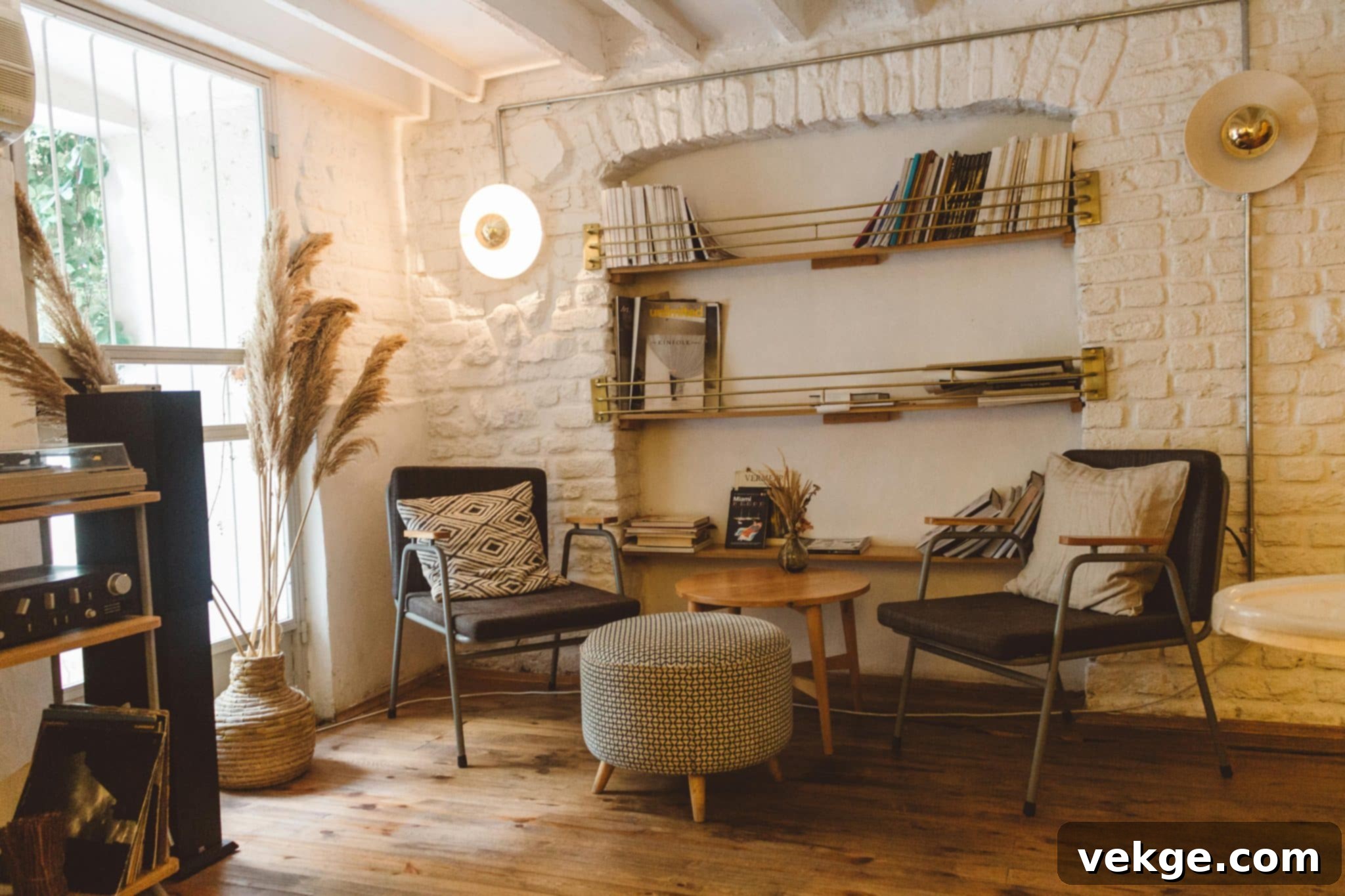Financing Your Bohemian Dream Home: A Comprehensive Mortgage Guide
The allure of a bohemian living space — a sanctuary filled with unique textures, global influences, natural elements, and an air of freedom — is incredibly strong for many aspiring homeowners. Envisioning your perfect artistic haven is the first step, but transforming that vision into a tangible reality requires careful planning, especially when it comes to financing. Understanding the intricate mortgage lending process is not just a formality; it’s a crucial foundation upon which your dream bohemian home will be built.
Embarking on the journey to create your bohemian living space is an exciting adventure, yet it comes with its own set of challenges. As you begin to collect inspiration for vintage furniture, eclectic decor, and lush indoor plants, the practical aspect of financing your home becomes paramount. This comprehensive guide is designed to provide you with essential mortgage lending tips, tailored to help you navigate the complexities of home financing and confidently achieve a stylish, comfortable, and uniquely bohemian sanctuary. For those already homeowners, exploring options like FHA refinancing programs can also be a valuable step in optimizing your current home loan or accessing equity.
Understanding Your Financial Readiness: The Foundation of Your Bohemian Sanctuary

Before you even begin browsing for lenders or open house listings, a thorough assessment of your financial standing is absolutely crucial. This foundational step will significantly impact the mortgage options available to you, the interest rates you’re offered, and ultimately, the affordability of your future bohemian abode.
Your Credit Score: The Gateway to Favorable Rates
Start by assessing your credit score. This three-digit number is a direct reflection of your financial reliability and plays a pivotal role in the mortgage application process. Lenders use it to gauge the risk of lending to you; a higher credit score (typically 740 and above) indicates lower risk, which translates into more favorable interest rates and better loan terms. Conversely, a lower score can lead to higher interest rates, making your mortgage more expensive over time. Obtain your credit report from all three major credit bureaus (Equifax, Experian, Transunion) to check for any inaccuracies and understand your current standing. If your score isn’t where you want it to be, focus on paying bills on time, reducing outstanding debt, and avoiding opening new credit lines before applying for a mortgage.
Debt-to-Income Ratio (DTI): A Key Indicator of Affordability
Another critical metric is your debt-to-income ratio (DTI). This ratio, expressed as a percentage, compares your total monthly debt payments (including car loans, student loans, credit card minimums, and the estimated new mortgage payment) to your gross monthly income. Lenders typically prefer a DTI of 36% or lower, though some programs may allow up to 43% or even higher under specific circumstances. A lower DTI signifies that you have ample income to manage your monthly payments, making you a more attractive borrower. To improve your DTI, consider paying down existing debts or increasing your income, both of which will demonstrate greater financial capacity to lenders.
Saving for a Down Payment: Your Equity Head Start
Saving for a substantial down payment is perhaps one of the most impactful financial steps you can take. The larger your down payment, the lower your loan amount will be, resulting in reduced monthly mortgage payments and less interest paid over the life of the loan. This financial flexibility can be invaluable, allowing you more freedom to invest in the unique decor, vintage finds, and custom art that will truly bring your bohemian vision to life without overstretching your budget.
Aim for at least 20% of the home’s purchase price to avoid Private Mortgage Insurance (PMI). PMI is an additional monthly fee charged by lenders to protect themselves if you default on your loan, and it can add a considerable, often non-deductible, cost to your payments over time. While some loan programs, like FHA loans, allow for much lower down payments (as little as 3.5%), they typically come with mortgage insurance premiums (MIP) that are similar to PMI but often last for the life of the loan. Explore various down payment assistance programs if a 20% down payment feels out of reach, but always weigh the long-term costs of mortgage insurance.
Budgeting Beyond the Mortgage: Embracing the Bohemian Lifestyle
When assessing your financial situation, it’s wise to factor in potential future expenses directly related to your bohemian lifestyle. Beyond the initial home purchase, consider the costs of unique decor items, artisan crafts, vintage furniture, or custom artwork that will help bring your vision to life. A truly bohemian space is often an evolving collection, and setting aside a dedicated budget for these aesthetic investments ensures that your mortgage payments remain manageable while still allowing continuous room for creative expression and personal touches in your living space. Don’t forget an emergency fund for unexpected home repairs – a crucial safety net for any homeowner.
Researching Lenders and Loan Options: Tailoring Your Mortgage to Your Bohemian Vision

Just as no two bohemian homes are exactly alike, not all lenders or loan options are created equal. Thorough research is essential before committing to a mortgage, ensuring you find a product that aligns perfectly with your financial goals and your long-term vision for your unique sanctuary.
Exploring Mortgage Types: Fixed, Adjustable, and Government-Backed
There are several types of mortgages, each with distinct features:
- Fixed-Rate Mortgages: These loans offer a consistent interest rate and monthly payment for the entire loan term, typically 15 or 30 years. They provide predictability and stability, making budgeting straightforward – a great option if you plan to stay in your bohemian haven for many years.
- Adjustable-Rate Mortgages (ARMs): ARMs typically offer a lower initial interest rate for a set period (e.g., 5, 7, or 10 years), after which the rate adjusts periodically based on market indices. While the initial lower payments can be appealing, the risk lies in potential rate increases, which could make your payments less predictable. ARMs might suit those who plan to sell or refinance before the fixed-rate period ends.
- Government-Backed Loans:
- FHA Loans: Insured by the Federal Housing Administration, these loans are popular for first-time homebuyers due to their lower down payment requirements (as little as 3.5%) and more flexible credit score criteria. They do, however, require mortgage insurance premiums.
- VA Loans: Offered to eligible veterans, service members, and surviving spouses, VA loans are a significant benefit, often requiring no down payment and no private mortgage insurance.
- USDA Loans: Designed for low-to-moderate-income buyers in eligible rural areas, USDA loans also offer zero down payment options, promoting homeownership in less dense regions.
Compare offers from various lenders – including traditional banks, credit unions, and dedicated mortgage companies – to secure the most favorable terms and interest rates for your specific situation. Don’t just look at the interest rate; consider the Annual Percentage Rate (APR), which includes fees and other costs, giving you a more complete picture of the loan’s overall cost.
Considering Alternative Financing Options
Beyond conventional lenders, consider alternative financing options. Online mortgage brokers can often provide access to a wider range of lenders and potentially more competitive rates, as they work with multiple institutions. Peer-to-peer lending platforms are another avenue, though less common for primary mortgages. Always be sure to read reviews, check the credibility, and verify the licensing of any lender or broker before sharing personal financial information or making a decision. Transparency and reputation are key when choosing a financial partner for your bohemian home.
The Importance of Pre-Approval: Your Advantage in the Home Search

One of the most critical and empowering steps in the mortgage process is getting pre-approved for a loan. This isn’t just a suggestion; it’s a strategic move that provides a multitude of benefits, particularly in a competitive housing market where unique, bohemian-style homes are highly sought after.
What Pre-Approval Entails and Its Benefits
The pre-approval process involves submitting comprehensive financial documents to your chosen lender. This typically includes recent tax returns, pay stubs, bank statements, and information about your debts and assets. The lender then conducts a thorough review of your financial health, including a hard credit inquiry, to determine how much they are willing to lend you. Once approved, you’ll receive an official pre-approval letter, outlining your estimated loan amount, interest rate, and terms. This letter is typically valid for 60 to 90 days.
The benefits of pre-approval are substantial:
- Clear Affordability: It gives you a clear and realistic understanding of how much home you can truly afford, helping you narrow your search to properties within your budget. This prevents the disappointment of falling in love with a home that’s out of reach.
- Serious Buyer Status: A pre-approval letter signals to sellers and real estate agents that you are a serious, qualified buyer. In a competitive market, an offer from a pre-approved buyer is often given preference over one from someone who hasn’t secured financing yet. This can be your decisive advantage when bidding on that perfect bohemian retreat.
- Faster Closing: Since much of your financial information has already been vetted, the pre-approval process can significantly streamline and speed up the closing process once your offer is accepted.
- Identify Potential Issues Early: This step can uncover any financial issues or discrepancies early on, giving you time to address them before they derail your home purchase.
It’s important to distinguish pre-approval from pre-qualification. Pre-qualification is a preliminary estimate based on self-reported information, while pre-approval is a conditional commitment from a lender based on verified financial data.
Navigating Closing Costs and Fees: Preparing for the Final Stretch

As you meticulously budget for your new bohemian haven, it’s easy to overlook a significant category of expenses: closing costs and fees. These are various charges associated with finalizing your mortgage and transferring property ownership, and they can add a substantial amount to your overall home purchase. Typically, closing costs range from 2% to 5% of the home’s purchase price, and they are paid at the closing table, separate from your down payment.
A Breakdown of Common Closing Costs
Understanding what each fee covers is vital. Common closing costs include:
- Loan Origination Fees: Charges by the lender for processing your loan application.
- Appraisal Fees: Costs for an independent appraiser to assess the home’s value.
- Title Insurance: Protects both the lender and buyer from disputes over property ownership.
- Attorney Fees: For legal services involved in the transaction (required in some states).
- Recording Fees: Paid to the local government to record the new deed and mortgage.
- Escrow Fees: Charges for the escrow company handling the funds and documents.
- Prepaid Expenses: Such as property taxes and homeowner’s insurance premiums, which are often collected for several months in advance to establish an escrow account.
- Discount Points: Optional fees paid to the lender to “buy down” your interest rate.
Strategies to Manage and Reduce Closing Costs
While many closing costs are non-negotiable, some can be influenced. You can:
- Negotiate with the Seller: In certain market conditions, you might negotiate for the seller to cover a portion of your closing costs as part of your purchase agreement.
- Compare Lender Fees: Different lenders may charge varying amounts for their specific fees (like origination or processing fees). Shopping around can save you money.
- Ask for Lender Credits: Some lenders might offer a credit towards your closing costs in exchange for a slightly higher interest rate. Calculate if this trade-off makes sense for your financial situation.
- Close at Month-End: You can save on prepaid interest by closing at the end of the month, as you’ll owe less daily interest before your first full mortgage payment is due.
Your lender is required to provide you with a Loan Estimate within three business days of your application, detailing all estimated closing costs. Review this document carefully and ask questions about any fees you don’t understand. Knowing these details can help you better plan financially and avoid unexpected surprises at closing, ensuring a smooth transition into your new bohemian home.
By diligently following these essential mortgage lending tips, you’ll be well-prepared and confident in creating your ideal bohemian living space. With careful planning, informed decisions, and a clear understanding of the financing process, securing your new home can be a smooth, successful, and ultimately rewarding journey. Welcome to your future bohemian sanctuary!
